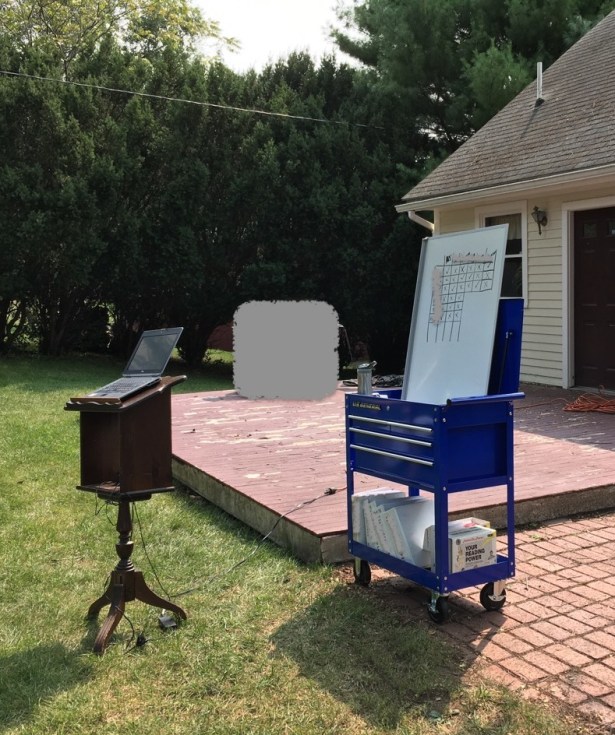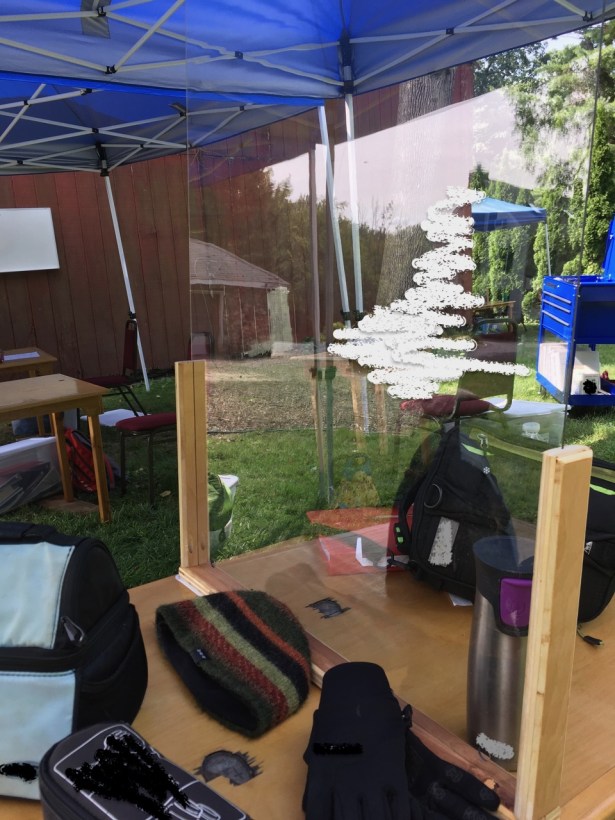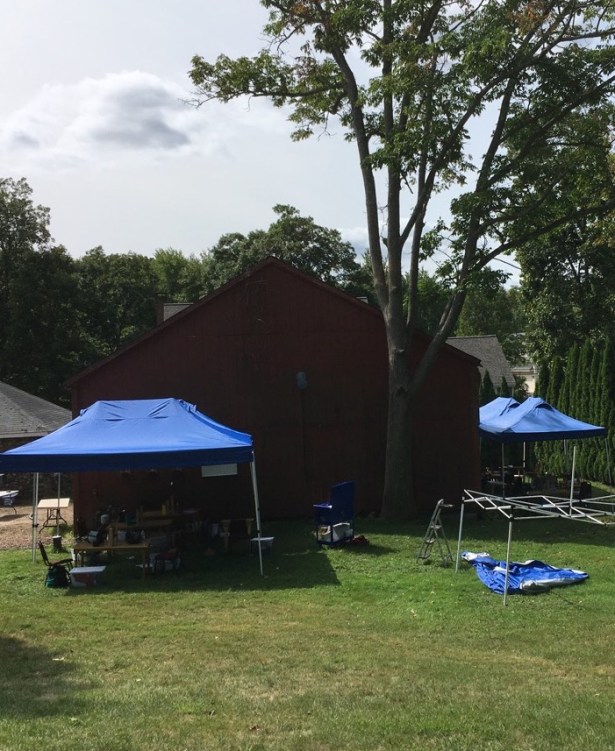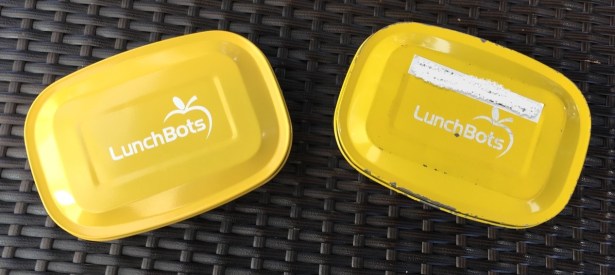Nervous families want to know if sending kids back to “in person” school during a pandemic is safe, and if it is worth the risk. Here’s what I’ve seen at my child’s school in September 2020.
I write this post first acknowledging my position as a parent with every† conceivable advantage. Having been on site every day since two days after Labor Day, I can share what the autumn of COVID-19 looks like at one small New England institution serving elementary and middle grade students.

Decision 2020: Remote or in person education
My younger child, who prefers learning in a group, was given the option by his school to attend in person or remotely. Our community has low COVID-19 infections rates that makes this a reasonable choice. Even better, “in person” classes would be conducted outdoors until the weather turns cold when autumn segues into winter.
In accordance with advice from the department of health, DS2‘s school is requiring* the kids to:
- maintain social distance at all times and
- to wear masks any time they aren’t seated at their assigned desks for working or eating.
 My child requested a return to in person school, and we agreed that he may go until they move indoors with the caveat that any surge in local virus outbreaks or lax enforcement of health protocols at school could change our position.
My child requested a return to in person school, and we agreed that he may go until they move indoors with the caveat that any surge in local virus outbreaks or lax enforcement of health protocols at school could change our position.
Even with low COVID-19 infection rates, I would not send my asthmatic son to school indoors at this point in time. We also have two elderly adults in our household, both with significant underlying medical conditions on the CDC’s watch list, so I’m on higher alert than I would be if I had only our nuclear family to consider.
Because I am a full time parent, I volunteered to help the teachers keep an eye on the children during lunch- and free-time. Recess inherently lacks the strict visual supervision of class time. My selfish reason for doing this is to make sure my kid isn’t more exposed in reality than official policy might suggest.
Setting self-concern aside, however, I also proposed myself for this new volunteer position because I knew that our teachers would have all of their usual work to do in addition to enforcing a slew of new rules that combine novelty with literal life and death consequences. Showing up and lending a hand seemed the very least I could do. My time is my own to spend and three other adults would remain present at my house to support my teen with his online work.
When I walk the playground for an hour and a half, the teachers have an opportunity to take a real break and eat lunch in peace. The kids still benefit from having a grown up—me!— available to remind them to replace their masks after they eat, and my extra set of eyes helps even the most active among them to maintain social distancing no matter how vigorously they are defending a fort, swinging on the tire swing, or digging a giant pit.
COVID-19 School Lesson 1: Create defined spaces minding social distance for everything fascinating
Here’s my first take-away advice for other adults, teachers and parents: kids who are engrossed in something are going to forget to mind their social distance. The younger the kid, the quicker this occurs. If awesome projects are happening, do everything you can to set up “stations of awesomeness” that are fixed to locations six feet apart!
An example at our school? The science teacher brought in several live frogs for a lesson. Afterwards, multiple kids wanted to hold the tiny creatures as the teacher cleared away equipment to her car. While each child did a great job waiting his or her turn, they were drawn closer as if by magnets whilst waiting. They started out sitting at opposite corners of a large blanket where they’d been assigned for the lesson, but nothing prevented the forward creep of excitement that all parents know from their own young kids. 
Separate frog habitats on individual, smaller towels with “waiting spots” assigned on other, distanced towels (one per kid) would have worked better than the larger blanket which was fine for a teacher-directed lesson with direct supervision. Visual distancing cues are good; physical barriers are better; using both together is best!
None of us wants to prevent kids from the deep concentration of fascination with their work, but we adults must step up to keep them safe while they are in a state of flow. “Six feet” is a pretty vague concept to any elementary school student; it’s utterly meaningless to one who’s distracted!
COVID-19 School Lesson 2: Kids need masks that fit well, especially once they are in motion
Another tip I’d offer parents is to watch your child play in the yard or at a park for a solid hour or so with a new mask on. It becomes very obvious on the playground when someone’s mask is ill-fitting.
 Watching the children organically form into a whooping, running mass as they re-accustomed themselves to being together was one of the most heart-lifting things I’ve seen since the pandemic began. These kids are thrilled to be in each other’s company again, and the joy of play was plain on every covered face. I felt terrible each time I had to interrupt a game to remind a kid that his mask was slipping.
Watching the children organically form into a whooping, running mass as they re-accustomed themselves to being together was one of the most heart-lifting things I’ve seen since the pandemic began. These kids are thrilled to be in each other’s company again, and the joy of play was plain on every covered face. I felt terrible each time I had to interrupt a game to remind a kid that his mask was slipping.
The same kid would struggle to follow the rules on one day but not the next for what appeared to be a non-behavioral reason: one mask fit that kid’s face better than the other.
Some of the little kids show up wearing masks that are too large and therefore floppy. Three older kids on different days tried using neck gaiters as face coverings, but each was constantly adjusting his tube of cloth as those simply don’t stay up once a child is in motion. Gaiters are not a good option for school face covering.
 Try to get your kid to jog around the block in a new mask before sending her with it to “in person” school. A kid with a mask that doesn’t fit well—or feel comfortable—is being set up for discipline and failure. There are many mask styles available now, so keep looking until you find one your child can tolerate.
Try to get your kid to jog around the block in a new mask before sending her with it to “in person” school. A kid with a mask that doesn’t fit well—or feel comfortable—is being set up for discipline and failure. There are many mask styles available now, so keep looking until you find one your child can tolerate.
A certain young child behaved beautifully every day but one; when I asked him what was going on with his mask that day, he admitted that it smelled funny. Mom and Dad, if you’re thinking of trying a new laundry detergent, consider doing the experiment on a Friday night and having the kids try on their masks well before school begins on Monday morning.
Another thing I wish every worried parent knew is how well the youngest kids are adapting to wearing a mask all day, every day. It already seems natural to most of them! From what I’ve seen, the littlest children acclimated quickly to what was just one more “first” in their short lives.
Our middle-group kids seem to be the most resistant to the need to wear masks. It’s tough growing into your “question authority” phase during a pandemic, plus these kids are better used to school and life without face coverings. I appreciate that our school is taking a hard line about the necessity of protecting others by taking precautions, but I feel for the rebellious ones.
Schools, make sure your pupils know when and where they are allowed to step aside for a mask break without breaking the rules. Some kids need to exercise this kind of autonomy more than others, or more often. Give them a way to do it safely when you can.
COVID-19 School Lesson 3: Educators who worked hard are now working HARDER
Though some people bemoan “lazy” teachers who took the job to get summers off, I think those are mostly people who’ve never managed groups of kids!
Professional educators tend to be people who sincerely want to help children achieve their potential. COVID-19 has foisted a lot of extra work onto teachers, none of it within the normal scope of training for the job. Oh, yes, and getting it wrong runs the risk of making children sick. I have to believe it is the rare educator who enjoys hurting children.
I am spending only about a quarter of the school day being vigilant on behalf of the pupils on our playground, and I am exhuasted by the time I get home from this duty. Sure, I live with chronic illness, so I’m hardly a model of vigor and vim, but keeping watch takes a lot out of anyone who cares about her charges.

Our school’s leader is a handy type. He was able to add plexiglass partitions to the kids’ work tables himself. This woodworking task was done during his “summer vacation.”
Don’t worry: the plexi extends above the wooden supports by another two times their length, but that’s hard to see on a small screen. The barrier extends well above the kids’ faces.
 On a fine September morning, tents nestled alongside a red-painted barn appear positively idyllic. School started with each child finding his desk ready for him, each with a personal bin for books and papers. The same fellow had to source and procure these new materials after doing the planning to figure out what was needed and how to pay for it.
On a fine September morning, tents nestled alongside a red-painted barn appear positively idyllic. School started with each child finding his desk ready for him, each with a personal bin for books and papers. The same fellow had to source and procure these new materials after doing the planning to figure out what was needed and how to pay for it.
Another bit of summer, consumed by COVID-19…
Upon arrival at school, kids help carry furniture and bins out of the barn to prepare for the new day.
But within the first week, a light rain highlighted a weakness of a certain style of canopy. Attempts to reach the manufacturer for parts proved that equipment bought from retail stores by small businesses—our school, in this case—often can’t be repaired economically.
A painful lesson for a tiny school without endowments or rich benefactors. Also, many extra hours of work outside the school day for a full time teacher.
 Of course, there is more to weather than rain. When the breeze picked up, kids realized that outdoor classrooms require heavier jackets much earlier in the season.
Of course, there is more to weather than rain. When the breeze picked up, kids realized that outdoor classrooms require heavier jackets much earlier in the season.
And, it turns out, large sheets of plexiglass have their own issues with the wind!

All of these little headaches have to be multiplied by the teachers’ love for their students and commitment to their well-being. They care if they get this right, and they want to keep the children safe.
At our school, most of the adults have years of experience doing the same jobs… in the same classrooms with their supplies just so. Though the school hasn’t moved, the transition to working outside the doors requires constant adjustments. That kind of effort consumes energy as well as time.
I suspect every member of the staff at our school feels like s/he is working a brand new job in a whole new environment while teaching. That is stressful, and that’s in addition to the requirement that these caring educators remember to remind kids as young as six years old to keep their distance and keep their masks on.
There’s no specific tip for this observation except to remind parents to be kinder than ever to their children’s teachers. Recognize that none of us has a monopoly on pandemic-induced stress. You and I may not have the same worst stressors during these crazy times, but odds are we both face some.
Two weeks into the new school year, I asked my son two questions this morning.
Are you able to learn in your socially distanced, outdoor classroom while wearing a mask?
Yes, he said. He’s learning just as well as always.
Then I asked him about socializing and play. Even with his mom on the playground annoying his peers, even with reminders and occasional rebukes about space and facial coverings, I asked him, is he having fun with his friends?
Yes, my son replied. He’s really happy to be back at school amongst other kids, even with the necessary restrictions.
For us, for now, in person education for this child is a risk worth taking.
♦
†Our employed household members continue to earn their usual paychecks, and both have the option to work from home. My home educated teen is attending all of the usual courses that we elect to outsource online. We have enough rooms for all this work to be conducted with relative privacy, and we had the means to upgrade our internet infrastructure over the summer to eliminate technical roadblocks we experienced in the spring.
I am counting my blessings, and they are myriad!
*Another change is the requirement to pack out all lunch detritus instead of disposing of potentially contaminated trash at school, and the kids no longer have access to a kitchenette for reheating their meals. My interest in waste free lunches and re-usable containers is serving us well. Hot food in insulated thermal jars is already receiving a warm welcome, and it is only mild September!




 My child requested a return to in person school, and we agreed that he may go until they move indoors with the caveat that any surge in local virus outbreaks or lax enforcement of health protocols at school could change our position.
My child requested a return to in person school, and we agreed that he may go until they move indoors with the caveat that any surge in local virus outbreaks or lax enforcement of health protocols at school could change our position.
 Watching the children organically form into a whooping, running mass as they re-accustomed themselves to being together was one of the most heart-lifting things I’ve seen since the pandemic began. These kids are thrilled to be in each other’s company again, and the joy of play was plain on every covered face. I felt terrible each time I had to interrupt a game to remind a kid that his mask was slipping.
Watching the children organically form into a whooping, running mass as they re-accustomed themselves to being together was one of the most heart-lifting things I’ve seen since the pandemic began. These kids are thrilled to be in each other’s company again, and the joy of play was plain on every covered face. I felt terrible each time I had to interrupt a game to remind a kid that his mask was slipping. Try to get your kid to jog around the block in a new mask before sending her with it to “in person” school. A kid with a mask that doesn’t fit well—or feel comfortable—is being set up for discipline and failure. There are many mask styles available now, so keep looking until you find one your child can tolerate.
Try to get your kid to jog around the block in a new mask before sending her with it to “in person” school. A kid with a mask that doesn’t fit well—or feel comfortable—is being set up for discipline and failure. There are many mask styles available now, so keep looking until you find one your child can tolerate.
 On a fine September morning, tents nestled alongside a red-painted barn appear positively idyllic. School started with each child finding his desk ready for him, each with a personal bin for books and papers. The same fellow had to source and procure these new materials after doing the planning to figure out what was needed and how to pay for it.
On a fine September morning, tents nestled alongside a red-painted barn appear positively idyllic. School started with each child finding his desk ready for him, each with a personal bin for books and papers. The same fellow had to source and procure these new materials after doing the planning to figure out what was needed and how to pay for it. Of course, there is more to weather than rain. When the breeze picked up, kids realized that outdoor classrooms require heavier jackets much earlier in the season.
Of course, there is more to weather than rain. When the breeze picked up, kids realized that outdoor classrooms require heavier jackets much earlier in the season.
 Some teachers aren’t at particularly high risk for complications from the novel coronavirus, and want to get back into classrooms quickly. By all means, let’s put those educators to work in communities where infection rates make that a sensible solution. Other teachers have pre-existing conditions or would prefer to teach remotely: there’s an audience
Some teachers aren’t at particularly high risk for complications from the novel coronavirus, and want to get back into classrooms quickly. By all means, let’s put those educators to work in communities where infection rates make that a sensible solution. Other teachers have pre-existing conditions or would prefer to teach remotely: there’s an audience



 Kids are resilient. Thank God! Most of the kids will be all right. That’s the best we can do in the face of a viral adversary that has killed 171,787 Americans
Kids are resilient. Thank God! Most of the kids will be all right. That’s the best we can do in the face of a viral adversary that has killed 171,787 Americans  Highly paid elected officials in D.C. and other capitals deserve the pressure and expectation of doing more, because they are the ones who dropped this particular ball. Give them the blame they’ve earned. The U.S.A. is failing in its attempt to manage the COVID-19 pandemic, but it isn’t for lack of effort on the part of average American parents.
Highly paid elected officials in D.C. and other capitals deserve the pressure and expectation of doing more, because they are the ones who dropped this particular ball. Give them the blame they’ve earned. The U.S.A. is failing in its attempt to manage the COVID-19 pandemic, but it isn’t for lack of effort on the part of average American parents.